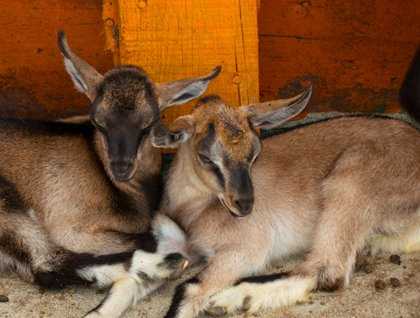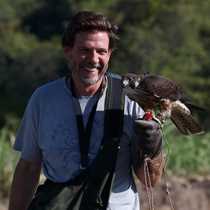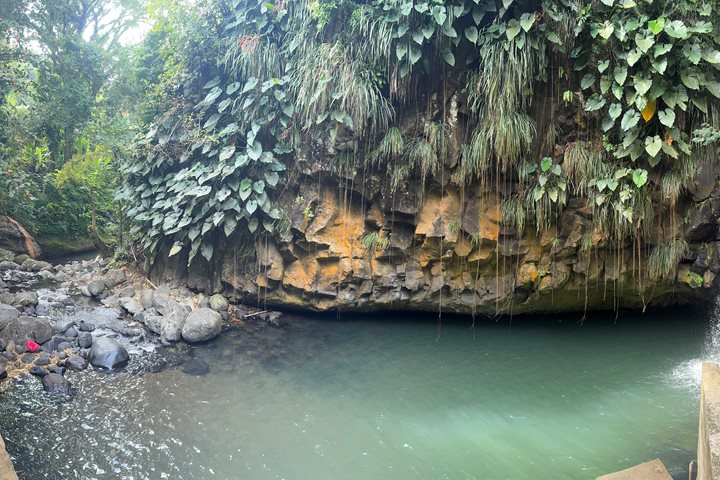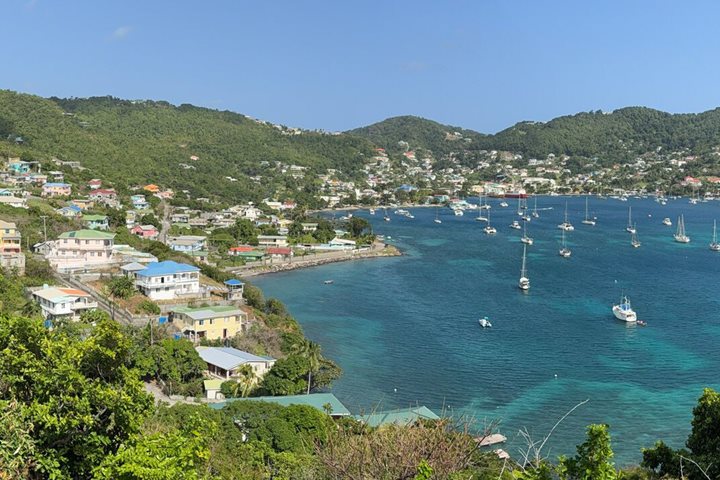The Sea Cloud dropped anchor in the beautiful Admiralty Bay at 7a.m. The sky was overcast from the welcome rain the island received last night. It has been an exceptionally dry month for the island and if they do not get rain they are forced to import it from St. Vincent. Before we disembarque I noticed a large school of very small baitfish swimming continually around the Sea Cloud, breaking out of the water, as they were being chased by herring-sized fish and fed on from the air by brown boobies. It was quite an amazing occurrence and lasted a good hour. The water of Princess Margaret Beach was a milky pale blue. Coconut palms moved slowly in the breeze. Bequia, pronounced Bek-way, is an Anglicized version of the old Carib Indian name for the island, meaning ‘the Island of the Clouds’ as the island frequently has clouds directly atop its highest points. The Carib native peoples who were here were exiled to one of the neighboring islands and eventually shipped off to RoiTan in Honduras where they became the Garifuma people.
Bequia is the largest of the nine dependencies of the nation “St. Vincent and the Grenadines.” World-class yachts frequent Bequia and the Grenadines as it has some of the finest sailing in the Caribbean. One of the most interesting competitions is the annual Bequia Easter Regatta, where yachts of every size from 50-meter sloops to local coconut boats race for prizes. The main city, indeed the only “city” on Bequia is Port Elizabeth. Port Elizabeth is a tiny village two streets deep with a wide variety of shops along its length. It has one of the better small bookshops in the Windward Islands. The bookstore specializes in nautical charts and has a number of books on the history of the Antilles and its peoples. There is a vigorous Rastafarian community on Bequia. They can be seen selling vegetables, fruits, and spices in the open market.
Our visit began in open-air pickup trucks with bench seats and canopies to protect from the sun. Fort Hamilton, a canon battery that in the 18th century was the principal defensive position guarding the bay and the capital of Port Elizabeth, was our first stop. The site is named after Alexander Hamilton—the American Secretary of the Treasury assassinated in a duel by Aaron Burr—who was born on the neighboring Leeward Island of Nevis. The view from Fort Hamilton was stunning, looking out over Port Elizabeth and Admiralty Bay. At its broadest point from Northwest Point to the promontory of Hope Bay it is less than three miles wide. The island is seven-square miles and has approximately 6,000 people.
Our next stop was a visit the Old Hegg Turtle Sanctuary. Orton “Brother” King began this sanctuary for the Hawksbill turtle 17 years ago. Brother King is a former free diver and hunter of turtles who decided that he had to stop killing turtles and begin to rescue them before they disappeared. He began with no training or knowledge of the animals save what he knew from having spent a life on the sea. He built his sanctuary, which now consists of a dozen or so pools on the edge of the sea. He receives baby turtles from the locals and raises then until they are five years old before releasing them. Brother King has a success rate of about 15%, a rate far better than the less than 3% they have if left to make it back to the sea after hatching. His work is entirely self-sustaining and he receives no support from the government. We were able to see a range of turtles from 3 months to 17 years old in the salt-water pools. Brother King has released over 900 turtles to date and he hopes to see some of them returning to hatch in the next few years. They live up to 200 years!
After leaving the turtle sanctuary we returned to the colorful open markets of Port Elizabeth and did some well deserved shopping. I noticed scrimshaw made from the teeth of pilot whales and other whale related products. Becquia still allows hunting of whales and they take two whales per year. They consume them on the island do not export the meat. This very week they took two whales and we saw whale meat drying on some racks purpose built for the occasion. I hasten to add that they hunt in the traditional manner from open boats with hand thrown harpoons.
Our next stop was a “Jack’s Bar,” a tropical watering hole nestled under coconut palms on Princess Margaret Bay. There we sampled some of the complimentary drinks, a wicked run punch made with coconut milk, banana, and other fruits. The sea is sufficiently salty that you do not need a life jacket to stay afloat. You just let yourself bob along—swimming without exercising! This evening we had the Captain’s Farewell dinner. Captain Komakin hosted a cocktail party on lido deck and we had another one of the spectacular meals on Sea Cloud. Sadly this is our last night on this historic sailing vessel. It has been a memorable experience. We joined Sea Cloud as a collection of individuals from all over the United States and Europe and leave with fond memories and lasting friendships. Let me wish everyone fair seas, a gently breeze and best of luck, until we meet again.









